- Accueil
- Pages cachées
- 22 MARS 2024 NEWS
22 MARS 2024 NEWS
INSTITUT SUPERIEUR D'ANTHROPOLOGIE
INSTITUT OF ANTHROPOLOGY
COURS ONLINE – COURS A DISTANCE
INSCRIPTIONS OUVERTES
REGISTER NOW
CHINE - Changzhi - The Great Jin Dynasty has returned to the world after a team of archaeologists uncovered three tombs from the 1115-1234 AD era, located in Changzhi city, Shanxi province. In Tomb M19 and Tomb M20, brick-carved arches, doors, and windows highlight the construction. Murals heavy on figures, floral patterns, and inscriptions also play throughout the space. And in Tomb M21, the chamber walls imitate wooden structures. “The painted flora, fauna, and colors are markedly different from the other two,” the report states, “leaving archeologists room for further interpretation.” Each tomb tells its own story—quite literally. With epitaphs and inscriptions, researchers can glean a bit more about the Jin Dynasty from each of the tombs, according to Archeology News. Tomb M19 offers up historical and geographical information dedicated to the ancestors of Qiangcheng Village. Tomb M20 narrates the story of He Jin’s filial piety.
3 Ancient Tombs Reveal New Secrets From the Great Jin Dynasty (popularmechanics.com)
SUEDE – 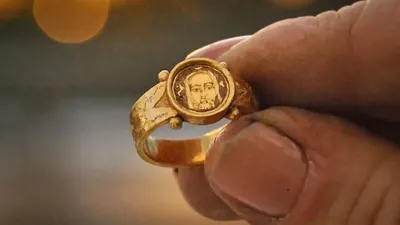 Kalmar - According to The Archaeologist, two investigations have been focused on a medieval city erected in the coastal city of Kalmar, in southwest Sweden. Although the city was destroyed in battle sometime in the 1600s, "sizable portions remained available for exploration." Researchers have found 50 medieval plots, around 10 streets, and segments of an ancient city wall which date between 1250 to 1650. "The surveys show that virtually all farms were burned in connection with the Danes' attack on the city in the summer of 1611. This is visible above all through fire horizons and razed buildings. We have also found a large number of projectiles, such as cannonballs, musket balls, and pistol bullets, but also swords," said Magnus Stibéus, a project manager at the Archaeologist. The more recent items date to about 400 years ago and all the discoveries have given scientists insight into dietary habits and societal changes that took place during the medieval period. "We have been able to lift the lid on the city's Middle Ages and have had the opportunity to study how people lived, what they ate and drank, and how this changed over time," Stibéus shared. "Archeology becomes like a peephole into medieval history that allows us to learn more about how life was several hundred years ago." Archaeologists found sites such as buildings and cellars as well as smaller, everyday objects including two "spectacular finds." One was a gold ring "in almost new condition with a Christ motif" which was found in "waste storage." "Probably someone was unlucky and lost the ring 500 years ago," explained Stibéus. The size of the ring indicates that it was most likely worn by a woman and resembles similar rings found in other parts of Sweden and Northern Finland. The other impressive find was an alsengem, a small glass stone believed to be a pilgrim amulet, which dates back to the 13th or 14th century. This particular find had three carved figures on it. "The building remains and the cultural warehouses form a historical archive that holds enormous amounts of information and stories about the political and economic ambitions, everyday life, and living conditions of previous generations. We get an insight into large parts of the medieval city and encounter traces of the social and economic existence of different groups; traders, craftsmen, civil servants, church people, poor and rich," Stibéus said.
Kalmar - According to The Archaeologist, two investigations have been focused on a medieval city erected in the coastal city of Kalmar, in southwest Sweden. Although the city was destroyed in battle sometime in the 1600s, "sizable portions remained available for exploration." Researchers have found 50 medieval plots, around 10 streets, and segments of an ancient city wall which date between 1250 to 1650. "The surveys show that virtually all farms were burned in connection with the Danes' attack on the city in the summer of 1611. This is visible above all through fire horizons and razed buildings. We have also found a large number of projectiles, such as cannonballs, musket balls, and pistol bullets, but also swords," said Magnus Stibéus, a project manager at the Archaeologist. The more recent items date to about 400 years ago and all the discoveries have given scientists insight into dietary habits and societal changes that took place during the medieval period. "We have been able to lift the lid on the city's Middle Ages and have had the opportunity to study how people lived, what they ate and drank, and how this changed over time," Stibéus shared. "Archeology becomes like a peephole into medieval history that allows us to learn more about how life was several hundred years ago." Archaeologists found sites such as buildings and cellars as well as smaller, everyday objects including two "spectacular finds." One was a gold ring "in almost new condition with a Christ motif" which was found in "waste storage." "Probably someone was unlucky and lost the ring 500 years ago," explained Stibéus. The size of the ring indicates that it was most likely worn by a woman and resembles similar rings found in other parts of Sweden and Northern Finland. The other impressive find was an alsengem, a small glass stone believed to be a pilgrim amulet, which dates back to the 13th or 14th century. This particular find had three carved figures on it. "The building remains and the cultural warehouses form a historical archive that holds enormous amounts of information and stories about the political and economic ambitions, everyday life, and living conditions of previous generations. We get an insight into large parts of the medieval city and encounter traces of the social and economic existence of different groups; traders, craftsmen, civil servants, church people, poor and rich," Stibéus said.
Ancient Gold Ring Showing the Face of Christ Uncovered by Archaeologists | CBN News
ITALIE – 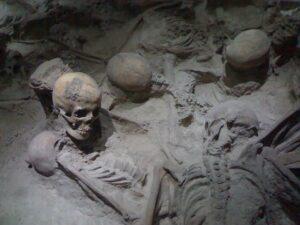 Herculaneum - No one knows her name. The hollow cavities that once held her eyes in her last, terrifying, desperate moment of life nearly 2,000 years ago stared back at me in silence. Surrounded by the articulated skeletal remains of family and friends, her bones told a story of a catastrophe that still echoes across time to this day. I was peering into a cave-like construction that once housed fishing equipment — one among 12 of them — neatly arranged as built in a straight-line row along the back perimeter of what is today a flat but stoney surface. It defined the dimensions of what was once an ancient city’s inviting seaside beach. Now only a caste replica of the bones she left behind, I knew there was a lost, untold history and personality here that will never be known to today’s living generations. At least for now, we know how she died, and how quickly. Through research conducted by a number of researchers, including a team under the leadership of Pierpaolo Petrone of the University Federico II in Naples, scientists have analyzed the skeletal remains of the victims of the volcanic catastrophe of ancient Herculaneum. This research was built upon and confirmed results of previous bioarchaeological and taphonomic studies. Based on the previous studies and their knowledge of how extreme heat can effect the human body, they formulated a horrific and vividly graphic hypothesis for study.
Herculaneum - No one knows her name. The hollow cavities that once held her eyes in her last, terrifying, desperate moment of life nearly 2,000 years ago stared back at me in silence. Surrounded by the articulated skeletal remains of family and friends, her bones told a story of a catastrophe that still echoes across time to this day. I was peering into a cave-like construction that once housed fishing equipment — one among 12 of them — neatly arranged as built in a straight-line row along the back perimeter of what is today a flat but stoney surface. It defined the dimensions of what was once an ancient city’s inviting seaside beach. Now only a caste replica of the bones she left behind, I knew there was a lost, untold history and personality here that will never be known to today’s living generations. At least for now, we know how she died, and how quickly. Through research conducted by a number of researchers, including a team under the leadership of Pierpaolo Petrone of the University Federico II in Naples, scientists have analyzed the skeletal remains of the victims of the volcanic catastrophe of ancient Herculaneum. This research was built upon and confirmed results of previous bioarchaeological and taphonomic studies. Based on the previous studies and their knowledge of how extreme heat can effect the human body, they formulated a horrific and vividly graphic hypothesis for study.
The Death Chambers of Herculaneum – Popular Archeology (popular-archaeology.com)
CHINE – 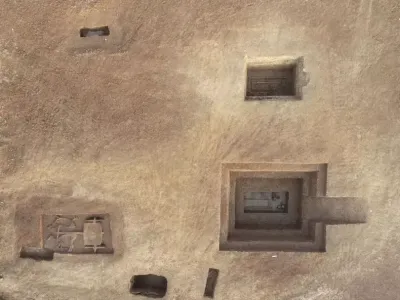
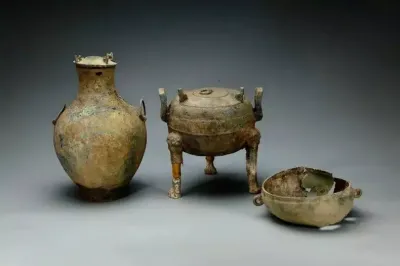 Xiangyang - Archaeologists have uncovered a large-scale ancient cemetery with dozens of tombs and numerous cultural relics in China. The Baizhuang Cemetery is located in the city of Xiangyang, in the northwestern Hubei province, the Institute of Archaeology, Chinese Academy of Social Sciences said in a statement. The cemetery was discovered by the Xiangyang Municipal Institute of Cultural Relics and Archaeology last summer during excavations conducted as part of an infrastructure project. After comprehensive cleaning, archaeologists identified a total of 176 tombs at the site. Apart from two tombs from China's Han dynasty period (206 B.C. to A.D. 220), the remainder are all pit tombs from the Warring States period. This period, which lasted from the 5th century B.C. until 221 B.C., was marked by warfare between various feuding Chinese kingdoms battling for dominance. This era was one of the most influential in the country's history, ending with the establishment of the first unified Chinese state. Among the tombs from the Warring States period are nine medium-sized examples with sloped passages. The largest of these have a total length (including the tomb passages) of more than 30 feet and a width of more than 16 feet. The remaining tombs found in the cemetery tend to be smaller and do not feature passages like the larger examples. During the excavations, the archaeologists also unearthed more than 500 cultural relics. These included hundreds of pieces of pottery, dozens of bronze artifacts—primarily weapons such as swords and spears—and some wooden utensils like combs, as well as other objects like jade rings.In one of the larger tombs—known as "M3"—the archaeologists identified several artifacts including bronze ritual vessels, swords and spoons. Intriguingly, just to the northwest of M3, the researchers found a "chariot and horse" burial pit. In this pit, a cart and two horses were buried, although the former is made of wood and has completely decayed. The chariot shaft faces north, while the two horses are lying on either side of it with their backs facing each other. The skull, ribs, shoulder blades and some leg bones of the horse on the east side remain. From the horse on the west side, the skull, a few ribs and some hind limb bone fragments are preserved. Based on the size of the M3 tomb, the combination of artifacts found inside of it and the nearby "horse" burial, the researchers speculated that it likely belonged to a high-ranking nobleman.
Xiangyang - Archaeologists have uncovered a large-scale ancient cemetery with dozens of tombs and numerous cultural relics in China. The Baizhuang Cemetery is located in the city of Xiangyang, in the northwestern Hubei province, the Institute of Archaeology, Chinese Academy of Social Sciences said in a statement. The cemetery was discovered by the Xiangyang Municipal Institute of Cultural Relics and Archaeology last summer during excavations conducted as part of an infrastructure project. After comprehensive cleaning, archaeologists identified a total of 176 tombs at the site. Apart from two tombs from China's Han dynasty period (206 B.C. to A.D. 220), the remainder are all pit tombs from the Warring States period. This period, which lasted from the 5th century B.C. until 221 B.C., was marked by warfare between various feuding Chinese kingdoms battling for dominance. This era was one of the most influential in the country's history, ending with the establishment of the first unified Chinese state. Among the tombs from the Warring States period are nine medium-sized examples with sloped passages. The largest of these have a total length (including the tomb passages) of more than 30 feet and a width of more than 16 feet. The remaining tombs found in the cemetery tend to be smaller and do not feature passages like the larger examples. During the excavations, the archaeologists also unearthed more than 500 cultural relics. These included hundreds of pieces of pottery, dozens of bronze artifacts—primarily weapons such as swords and spears—and some wooden utensils like combs, as well as other objects like jade rings.In one of the larger tombs—known as "M3"—the archaeologists identified several artifacts including bronze ritual vessels, swords and spoons. Intriguingly, just to the northwest of M3, the researchers found a "chariot and horse" burial pit. In this pit, a cart and two horses were buried, although the former is made of wood and has completely decayed. The chariot shaft faces north, while the two horses are lying on either side of it with their backs facing each other. The skull, ribs, shoulder blades and some leg bones of the horse on the east side remain. From the horse on the west side, the skull, a few ribs and some hind limb bone fragments are preserved. Based on the size of the M3 tomb, the combination of artifacts found inside of it and the nearby "horse" burial, the researchers speculated that it likely belonged to a high-ranking nobleman.
Archaeologists Discover 174 Tombs Dating to China's Warring States Period (newsweek.com)
PANAMA -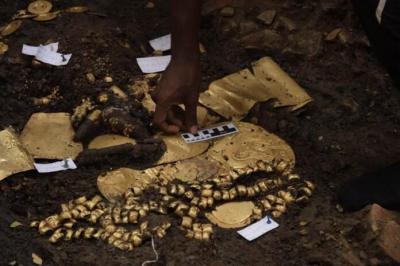 x El Caño - An array of golden artifacts and human remains have been discovered in Panama belonging to a religious leader of a non-Mayan, pre-Colombian society. Little is known about the nature of the society, but the discoveries, found in the ninth excavated tomb at an archaeological site called El Caño, present some intriguing clues. Dating to 750 to 800 CE, the individual for whom the tomb was built was probably a 40-year-old man, and has been nicknamed The Lord of Flutes based on the presence of several animal bone flutes found in the tomb. Buried face-down atop a woman, a practice seldom seen in the region, archaeologists determined he was a religious leader as he was “buried with flutes and bells and not, as in the case of other lords found at the same site, with axes, spears, and objects made with teeth of large predators.” “This calls attention to the importance of religion in this society,” Dr. Julia Mayo, the excavation’s leader and the director of the El Caño Foundation, told CNN in an email. “After the death of these people, (it was believed that) a constant communication was established between the ancestor and his descendants.” Bedecked in gold, the Lord of Flutes was clearly a leader who sat at the top of the social hierarchy, but the nature of the artifacts reveals that he may have maintained long-distance connections with other chieftains. The treasure included 5 golden pectoral ornaments, 2 belts made entirely of golden beads, 4 bracelets, 8 earrings—2 in the shape of human figures (a man and a woman), 1 in the shape of a double crocodile, and 5 made of gold-plated sperm whale teeth—1 necklace of small circular beads, a set of circular gold plates, and 2 bells. Many of the objects resemble golden pieces found in the Quimbaya region of Colombia, researchers said, suggesting that trade may have linked the two regions. The site of El Caño was a religious center and necropolis, a Greek word for City of the Dead. Ghastly as it is to us today, the tombs excavated so far have shown that when the important people in the cemetery died, human sacrifices often accompanied them to the grave. Some of the higher-ranking graves have turned up between 8 and 32 bodies. It’s considered obvious that the woman buried with the Lord of Flutes had some social relationship to him, though nothing indicates marriage necessarily. Bodies buried face down is common practice, said Mayo’s colleague Nicole Smith-Guzmán, but face down atop someone else has not been seen at El Caño before—rather only at another archaeological site called Sitio Sierra. When gold-filled graves are found in Latin America, the knee-jerk reaction is to imagine one of the three great empires of Maya, Mexica, or Inca, but the discoveries show that throughout the history of civilization, the Western Hemisphere boasted dozens of complex and rich societies, ancient Panama included.
x El Caño - An array of golden artifacts and human remains have been discovered in Panama belonging to a religious leader of a non-Mayan, pre-Colombian society. Little is known about the nature of the society, but the discoveries, found in the ninth excavated tomb at an archaeological site called El Caño, present some intriguing clues. Dating to 750 to 800 CE, the individual for whom the tomb was built was probably a 40-year-old man, and has been nicknamed The Lord of Flutes based on the presence of several animal bone flutes found in the tomb. Buried face-down atop a woman, a practice seldom seen in the region, archaeologists determined he was a religious leader as he was “buried with flutes and bells and not, as in the case of other lords found at the same site, with axes, spears, and objects made with teeth of large predators.” “This calls attention to the importance of religion in this society,” Dr. Julia Mayo, the excavation’s leader and the director of the El Caño Foundation, told CNN in an email. “After the death of these people, (it was believed that) a constant communication was established between the ancestor and his descendants.” Bedecked in gold, the Lord of Flutes was clearly a leader who sat at the top of the social hierarchy, but the nature of the artifacts reveals that he may have maintained long-distance connections with other chieftains. The treasure included 5 golden pectoral ornaments, 2 belts made entirely of golden beads, 4 bracelets, 8 earrings—2 in the shape of human figures (a man and a woman), 1 in the shape of a double crocodile, and 5 made of gold-plated sperm whale teeth—1 necklace of small circular beads, a set of circular gold plates, and 2 bells. Many of the objects resemble golden pieces found in the Quimbaya region of Colombia, researchers said, suggesting that trade may have linked the two regions. The site of El Caño was a religious center and necropolis, a Greek word for City of the Dead. Ghastly as it is to us today, the tombs excavated so far have shown that when the important people in the cemetery died, human sacrifices often accompanied them to the grave. Some of the higher-ranking graves have turned up between 8 and 32 bodies. It’s considered obvious that the woman buried with the Lord of Flutes had some social relationship to him, though nothing indicates marriage necessarily. Bodies buried face down is common practice, said Mayo’s colleague Nicole Smith-Guzmán, but face down atop someone else has not been seen at El Caño before—rather only at another archaeological site called Sitio Sierra. When gold-filled graves are found in Latin America, the knee-jerk reaction is to imagine one of the three great empires of Maya, Mexica, or Inca, but the discoveries show that throughout the history of civilization, the Western Hemisphere boasted dozens of complex and rich societies, ancient Panama included.
Heaps of Gold Uncovered in 1,200-year-old Pre-Colombian Tomb in Panama (goodnewsnetwork.org)
NEPAL -Chokhopani - An archeological study conducted by a team of international scientists has identified tantalizing clues about early malaria in Nepal and the role that long-distance trade may have played in its spread. "The team used a metagenomic approach to identify ancient DNA from malaria parasites preserved in human skeletal remains to explore the history of this disease," the study said, adding that the team presented the earliest identified case of P. falciparum malaria in an individual from the high-altitude site of Chokhopani in Upper Mustang, dating to c. 804-765 calBCE. "This site lies above the endemic range of malaria-transmitting mosquitoes in Nepal today, suggesting that the individual from Chokhopani may have acquired their infection during travel in lowland regions," the study revealed, "As such, this represents a rare case-study in which infectious disease status sheds light on both individual mobility and trans-altitudinal connectivity in the Himalayas." For the past 12 years, an international team of scientists, led by Dr Mark Aldenderfer (University of California, Merced) and Dr Christina Warinner (Harvard University), has applied cutting-edge techniques in the Upper Mustang, with the goal of understanding the lives of the first people to settle the High Himalayas more than 3,400 years ago and to reconstruct the trade routes they controlled for nearly three millennia. According to Mark, recent advances in the biological sciences are opening up dramatic new opportunities to study the human past. "Drawing on decades of archaeological fieldwork, our team used ancient DNA technologies to sequence the genomes and reconstruct the origin of early people in the High Himalayas and neighboring Tibetan Plateau," he said, adding that they also studied genetic adaptations found in ancient and present-day Himalayan populations that help people live above 4,000 meters above sea level. According to Mark, located some 4000 meters above sea level, in the Kali Gandaki river valley of the Upper Mustang region, lies the sky cave of Samdzong. Archeological excavations conducted, between 2010 and 2012, revealed several tombs, among which the tomb 5, which contained human remains and cultural artifacts associated with food and beverage production. Among these artifacts, copper vessels, dated to the 6-7th century CE, are thought to be associated with the brewing and consumption of chhaang, a typical Tibetan barley wine. "After conducting DNA extraction in a dedicated ancient DNA cleanroom facility, we shotgun and target captured and sequenced these samples, to check both for plant and microbiome composition," the scientist said, adding, "The microbial signal present in these samples revealed an assortment of microbes associated with alcoholic fermentation, while the plant DNA matched with barley reference genomes. Taken together, these findings suggest the production of chaang in the Upper Mustang region in the early 7th century CE." According to the study, the team used a new technique called metagenomics to investigate residues found at the bottom of a 1,600-year-old copper cauldron and identified that it once contained chaang – making it the earliest chaang found to date. "We introduced three paleogenomics projects our team is conducting in Nepal and explained how ancient DNA can be used answer key questions about life in ancient Nepal - including how and when ancient peoples first settled the high Himalayan valleys, the antiquity of malaria and its spread by trade, and the ancient art of brewing chaang," Christina informed. Over the course of the project, the team has also excavated and conducted research at seven archaeological sites in Mustang and neighboring Manang. "Based on this research, we now know that people entered Mustang by 1500 BCE, and through the study of ancient DNA, have found that they are ultimately descended from peoples from the Tibetan plateau," Mark said, adding that their research has revealed a complex set of mortuary practices over time, and archaeometric studies of glass beads, metals, and other artifacts show that Upper Mustang was connected societies to South Asia as well as Central Asia and the Middle East.
GRECE – 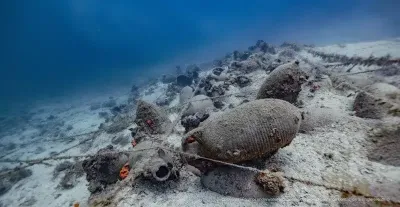 Fournoi - Excavations of an ancient Byzantine shipwreck off the coast of Fournoi near Samos, Greece are bringing new finds onto the surface. The wreck has been systematically excavated since 2021 and has been selected for intensive investigation due to the extremely interesting cargo it carries. The amphorae found in the sand near the wreck, along with the wooden skeleton of the ship itself, were in remarkably good condition. Experts believe that the ship’s wooden framing survived throughout the centuries because it was crushed under the rest of the ship and oxygen couldn’t reach it, stalling the process of decay.So far eight different amphora types have been recorded, originating from Crimea, Sinope of the Pontus region in the Black Sea, as well as from the Aegean islands and the Phocaean region of Asia Minor. The scattering of the finds on the seabed seems to indicate a partial loss of cargo before the ship sank. The recovered pottery was particularly enlightening, in terms of the more precise chronological inclusion of the wreck, which can now be safely dated between 480 and 520 AD, probably during the years of Emperor Anastasios I (491 – 518 AD), says a press release by the Greek Ministry of Culture. In parallel with the excavation of the wreck, findings from three more wrecks at the Fournoi archipelago were recovered, which are intended to be exhibited at the local archeological museum which is under construction. Among these finds are a giant archaic anchor obelisk and amphorae from shipwrecks of the 6th to 8th centuries A.D.
Fournoi - Excavations of an ancient Byzantine shipwreck off the coast of Fournoi near Samos, Greece are bringing new finds onto the surface. The wreck has been systematically excavated since 2021 and has been selected for intensive investigation due to the extremely interesting cargo it carries. The amphorae found in the sand near the wreck, along with the wooden skeleton of the ship itself, were in remarkably good condition. Experts believe that the ship’s wooden framing survived throughout the centuries because it was crushed under the rest of the ship and oxygen couldn’t reach it, stalling the process of decay.So far eight different amphora types have been recorded, originating from Crimea, Sinope of the Pontus region in the Black Sea, as well as from the Aegean islands and the Phocaean region of Asia Minor. The scattering of the finds on the seabed seems to indicate a partial loss of cargo before the ship sank. The recovered pottery was particularly enlightening, in terms of the more precise chronological inclusion of the wreck, which can now be safely dated between 480 and 520 AD, probably during the years of Emperor Anastasios I (491 – 518 AD), says a press release by the Greek Ministry of Culture. In parallel with the excavation of the wreck, findings from three more wrecks at the Fournoi archipelago were recovered, which are intended to be exhibited at the local archeological museum which is under construction. Among these finds are a giant archaic anchor obelisk and amphorae from shipwrecks of the 6th to 8th centuries A.D.
Dozens of Amphorae Recovered from Ancient Byzantine Shipwreck in Greece - GreekReporter.com